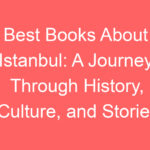
Interesting and Fun Facts About Istanbul
Istanbul is a city like no other — a place where East meets West, ancient history meets modern life, and hidden gems are waiting at every corner. Beyond its iconic skyline of minarets and domes, Istanbul offers layers of culture, mystery, and quirky surprises. To truly understand this city is to explore its blend of empires, legends, religions, and daily traditions. Here are some of the most fascinating and fun facts about this extraordinary metropolis.
Table Of Content
- 🌍 A City on Two Continents
- 🏛️ Empires Written in Stone
- 🛍️ The Grand Bazaar — World’s Oldest Mall
- 🕋 Built on Seven Hills
- 💧 Underground Secrets: The Basilica Cistern
- 🕌 Hagia Sophia’s Many Lives
- 🐱 City of Cats
- 🌙 The Mahya Tradition
- 🛶 Kayaking in the Golden Horn
- 🕵️ Hidden Gems and Quirky Tales
- 🌷 The Tulip’s True Home
- 🏛️ The Valens Aqueduct
- 🕌 More Lesser-Known Facts
- ✨ Final Thoughts
- Related Posts
🌍 A City on Two Continents
Istanbul is the only major city in the world that straddles two continents — Europe and Asia. The Bosphorus Strait divides the two sides, with ferries connecting them daily. For locals, commuting between continents is part of everyday life, while for visitors, it feels like magic to cross from one world to another in just 20 minutes. This unique geography makes Istanbul a cultural bridge, where European cafés and art galleries coexist with Asian tea houses and spice markets. Every ride across the Bosphorus is like stepping between two worlds.
🏛️ Empires Written in Stone
The city has been the capital of two great empires: the Byzantine (Eastern Roman) Empire and the Ottoman Empire. Each left its mark, from the grand mosaics of Hagia Sophia to the majestic domes of the Blue Mosque. During Byzantine times, the city was known as Constantinople, a jewel of Christianity and trade. The Ottomans later transformed it into the heart of the Islamic world, filling it with palaces, mosques, and bazaars. Walking through Istanbul feels like walking through multiple centuries at once, with Roman columns, Ottoman fountains, and modern skyscrapers side by side.
🛍️ The Grand Bazaar — World’s Oldest Mall
Built in the 15th century, the Grand Bazaar (Kapalıçarşı) is one of the oldest and largest covered markets in the world. It has over 4,000 shops and 61 covered streets, buzzing with traders selling carpets, spices, jewelry, lanterns, and antiques. It’s not just a shopping spot; it’s a living, breathing world of its own. Visitors can easily get lost in its labyrinth of alleys, discovering tiny workshops where artisans still practice centuries-old crafts. Bargaining is part of the fun, and the atmosphere feels unchanged since the time of the sultans.
🕋 Built on Seven Hills
Just like Rome, historic Istanbul was built on seven hills. Many of its famous mosques — including Hagia Sophia, Süleymaniye, and Sultanahmet (Blue Mosque) — crown these hilltops, giving the city its striking skyline. From these vantage points, you can see the shimmering waters of the Bosphorus, the Golden Horn, and the sprawl of Istanbul’s neighborhoods. This topography helped shape the city’s defense, architecture, and even daily life.
💧 Underground Secrets: The Basilica Cistern
Beneath the busy streets lies the Basilica Cistern, often called the “Sunken Palace.” This massive underground reservoir, supported by 336 marble columns, once stored water for the Byzantine palace. Visitors can still wander its atmospheric pathways, where dim lights, echoes of dripping water, and the mysterious Medusa head carvings create a hauntingly beautiful atmosphere. The cistern has even been featured in films like From Russia With Love and Inferno.
🕌 Hagia Sophia’s Many Lives
Few buildings have lived as many lives as Hagia Sophia. Constructed as a Christian church in 537 CE, it was later transformed into a mosque, then a museum in the 20th century, and today functions again as a mosque. Its soaring dome, revolutionary for its time, is one of the architectural wonders of the world. Inside, visitors can still find both Christian mosaics and Islamic calligraphy — a powerful symbol of the city’s layered identity.
🐱 City of Cats
Cats are everywhere in Istanbul — lounging on café chairs, roaming mosques, or sunbathing along the Bosphorus. Locals feed and care for them, and the city has even become famous for its love of cats, featured in the acclaimed documentary Kedi. For centuries, cats have been cherished as protectors against rats and symbols of good fortune. In Istanbul, they are not just pets — they are part of the city’s soul.
🌙 The Mahya Tradition
During Ramadan, mosques in Istanbul light up with special illuminated messages strung between minarets. Known as Mahya, these glowing signs often feature inspiring phrases, prayers, or patterns. The tradition dates back to the 17th century and is unique to Turkey. Today, artisans continue this delicate craft, and the glowing words across the night sky add a sense of magic to the holy month.
🛶 Kayaking in the Golden Horn
Most visitors take a ferry, but adventurous locals sometimes explore the Golden Horn by kayak or small boat. This horn‑shaped inlet has sheltered ships since Byzantine times, and from the water you get an entirely different perspective of Istanbul’s layered history. Paddling under bridges and past colorful houses gives you the feeling of discovering a quieter, hidden side of the city.
🕵️ Hidden Gems and Quirky Tales
- 🕊️ Birds Don’t Perch Mosque (Kuşkonmaz Camii): Designed with such smooth domes and surfaces that birds avoid landing on it.
- ⛲ German Fountain in Sultanahmet: Built in Germany, shipped piece by piece, and reassembled in 1900 as a gift from Kaiser Wilhelm II.
- ⚔️ Viking Graffiti in Hagia Sophia: A runic inscription scratched by a Viking mercenary centuries ago still survives inside the church.
- ☕ Pierre Loti Hill: A café with sweeping Golden Horn views named after the French writer who adored the city.
- 🏘️ Soğukçeşme Street: A picturesque lane of Ottoman-era wooden houses right beside Hagia Sophia, often overlooked by tourists.
- ⚓ Yenikapı Archaeological Finds: During metro construction, dozens of ancient shipwrecks and Byzantine artifacts were discovered underground, rewriting the city’s maritime history.
🌷 The Tulip’s True Home
Though often associated with the Netherlands, tulips actually originated in the Ottoman Empire. In the 18th century, Istanbul experienced a cultural period called the “Tulip Era,” marked by poetry, art, and gardens. Today, Emirgan Park revives that tradition each spring with its spectacular Tulip Festival, planting millions of tulips in every imaginable color. For locals, the tulip remains a symbol of beauty, wealth, and cultural pride.
🏛️ The Valens Aqueduct
Many visitors miss it, but the Roman‑era Valens Aqueduct still stretches across central Istanbul. Built in the 4th century and extended by both Byzantines and Ottomans, it once carried water to the city. Today it towers above busy streets and modern cars, a reminder of Istanbul’s ability to blend past and present. Standing beneath it, you can almost hear the echoes of ancient Constantinople.
🕌 More Lesser-Known Facts
- 🚇 The Tünel Funicular: Istanbul is home to the second-oldest underground metro line in the world, after London — the Tünel, opened in 1875.
- 🌀 Whirling Dervishes: The mystical Mevlevi order performs spiritual dances, and Istanbul hosts many ceremonies where visitors can watch this centuries-old tradition.
- 🍞 Street Food Culture: From simit (sesame bread rings) to midye dolma (stuffed mussels), Istanbul’s street food scene is as important to its identity as its monuments.
- 🏟️ Football Rivalries: The city is home to three of Turkey’s biggest football clubs — Galatasaray, Fenerbahçe, and Beşiktaş — and match days bring the city alive with chants, colors, and fireworks.
✨ Final Thoughts
Istanbul is not just a city — it’s a storybook of empires, legends, and everyday life. From cats and cisterns to tulips and minarets, every corner hides a story worth discovering. Whether you’re exploring the bustling bazaars, quiet backstreets of Balat, or the hidden graffiti of a Viking, Istanbul never stops surprising. With every ferry ride, every alley, and every meal, you discover that Istanbul is both timeless and ever-changing — a city that belongs to yesterday, today, and tomorrow.

